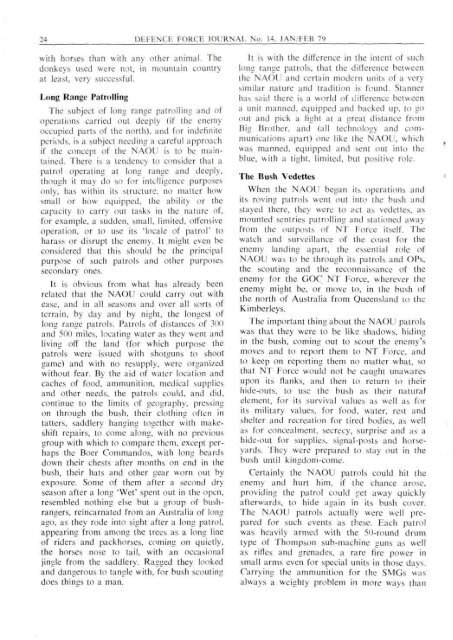ISSUE 14 : Jan/Feb - 1979 - Australian Defence Force Journal
ISSUE 14 : Jan/Feb - 1979 - Australian Defence Force Journal
ISSUE 14 : Jan/Feb - 1979 - Australian Defence Force Journal
Create successful ePaper yourself
Turn your PDF publications into a flip-book with our unique Google optimized e-Paper software.
24 DEFENCE FORCE JOURNAL No. <strong>14</strong>, JAN FEB 79with horses than with any other animal. Thedonkeys used were not, in mountain countryat least, very successful.Long Range PatrollingThe subject of long range patrolling and ofoperations carried out deeply (if the enemyoccupied parts of the north), and for indefiniteperiods, is a subject needing a careful approachif the concept of the NAOU is to be maintained.There is a tendency to consider that apatrol operating at long range and deeply,though it may do so for intelligence purposesonly, has within its structure, no matter howsmall or how equipped, the ability or thecapacity to carry out tasks in the nature of,for example, a sudden, small, limited, offensiveoperation, or to use its 'locale of patrol' toharass or disrupt the enemy. It might even beconsidered that this should be the principalpurpose of such patrols and other purposessecondary ones.It is obvious from what has already beenrelated that the NAOU could carry out withease, and in all seasons and over all sorts ofterrain, by day and by night, the longest oflong range patrols. Patrols of distances of 300and 500 miles, locating water as they went andliving off the land (for which purpose thepatrols were issued with shotguns to shootgame) and with no resupply, were organizedwithout fear. By the aid of water location andcaches of food, ammunition, medical suppliesand other needs, the patrols could, and did,continue to the limits of geography, pressingon through the bush, their clothing often intatters, saddlery hanging together with makeshiftrepairs, to come along, with no previousgroup with which to compare them, except perhapsthe Boer Commandos, with long beardsdown their chests after months on end in thebush, their hats and other gear worn out byexposure. Some of them after a second dryseason after a long 'Wet' spent out in the open,resembled nothing else but a group of bushrangers,reincarnated from an Australia of longago, as they rode into sight after a long patrol,appearing from among the trees as a long lineof riders and packhorses, coming on quietly.the horses nose to tail, with an occasionaljingle from the saddlery. Ragged they lookedand dangerous to tangle with, for bush scoutingdoes things to a man.It is with the difference in the intent of suchlong range patrols, that the difference betweenthe NAOU and certain modern units of a verysimilar nature and tradition is found. Stannerhas said there is a world of difference betweena unit manned, equipped and backed up, to goout and pick a fight at a great distance fromBig Brother, and (all technology and communicationsapart) one like the NAOU, whichwas manned, equipped and sent out into theblue, with a tight, limited, but positive role.The Hush VedettesWhen the NAOU began its operations andits roving patrols went out into the bush andstayed there, they were to act as vedettes, asmounted sentries patrolling and stationed awayfrom the outposts of NT <strong>Force</strong> itself. Thewatch and surveillance of the coast for theenemy landing apart, the essential role ofNAOU was to be through its patrols and OPs,the scouting and the reconnaissance of theenemy for the GOC NT <strong>Force</strong>, wherever theenemy might be, or move to, in the bush ofthe north of Australia from Queensland to theKimberleys.The important thing about the NAOU patrolswas that they were to be like shadows, hidingin the bush, coming out to scout the enemy'smoves and to report them to NT <strong>Force</strong>, andto keep on reporting them no matter what, sothat NT <strong>Force</strong> would not be caught unawaresupon its flanks, and then to return to theirhide-outs, to use the bush as their naturalelement, for its survival values as well as forits military values, for food, water, rest andshelter and recreation for tired bodies, as wellas for concealment, secrecy, surprise and as ahide-out for supplies, signal-posts and horseyards.They were prepared to stay out in thebush until kingdom-come.Certainly the NAOU patrols could hit theenemy and hurt him, if the chance arose,providing the patrol could get away quicklyafterwards, to hide again in its bush cover.The NAOU patrols actually were well preparedfor such events as these. Each patrolwas heavily armed with the 50-round drumtype of Thompson sub-machine guns as wellas rifles and grenades, a rare fire power insmall arms even for special units in those days.Carrying the ammunition for the SMGs wasalways a weighty problem in more ways than

















